
COMPACT COMPONENT SYSTEM
For Customer Use:
Enter below the Model No. and Serial INSTRUCTIONS No. which are located either on the rear, bottom or side of the cabinet. Retain this
information for future reference.
Model No.
Serial No.

COMPACT COMPONENT SYSTEM
For Customer Use:
Enter below the Model No. and Serial INSTRUCTIONS No. which are located either on the rear, bottom or side of the cabinet. Retain this
information for future reference.
Model No.
Serial No.

Warnings, Cautions and Others
Mises en garde, pr??cautions et indications diverses
DO NOT REMOVE COVER (OR BACK).
NO USER SERVICEABLE PARTS INSIDE.
REFER SERVICING TO QUALIFIED SERVICE PERSONNEL.
The lightning flash with arrowhead symbol, within an equilateral triangle is intended to alert the user to the presence of uninsulated "dangerous voltage" within the product's enclosure that may be of sufficient magnitude to constitute a risk of electric shock to persons.
The exclamation point within an equilateral triangle is intended to alert the user to the presence of important operating and maintenance (servicing) instructions in the literature accompanying the appliance.
WARNING: TO REDUCE THE RISK OF FIRE
OR ELECTRIC SHOCK, DO NOT EXPOSE
THIS APPLIANCE TO RAIN OR MOISTURE.
For U.S.A.
This equipment has been tested and found to comply with the limits for a Class B digital device, pursuant to part 15 of the FCC Rules.These limits are designed to provide reasonable protection against harmful interference in a residential installation.
This equipment generates, uses and can radiate radio frequency energy and, if not installed and used in accordance with the instructions, may cause harmful interference to radio communications. However, there is no guarantee that interference will not occur in a particular installation. If this equipment does cause harmful interference to radio or television reception, which can be determined by turning the equipment off and on, the user is encouraged to try to correct the interference by one or more of the following measures:
Reorient or relocate the receiving antenna. Increase the separation between the equipment and receiver.
Connect the equipment into an outlet on a circuit different from that to which the receiver is connected.
Consult the dealer or an experienced radio/TV technician for help.
CAUTION
To reduce the risk of electrical shocks, fire, etc.:
1Do not remove screws, covers or cabinet.
2Do not expose this appliance to rain or moisture.
ATTENTION
Afin d?????viter tout risque d?????lectrocution, d???incendie, etc.:
1Ne pas enlever les vis ni les panneaux et ne pas ouvrir le coffret de l???appareil.
2Ne pas exposer l???appareil ?? la pluie ni ?? l???humidit??.
 button!
button!
Disconnect the mains plug to shut the power off completely. The STANDBY/ON  button in any position does not disconnect the mains line. The power can be remote controlled.
button in any position does not disconnect the mains line. The power can be remote controlled.
 Commutateur!
Commutateur!
D??connecter la fiche de secteur pour couper compl??tement le courant. Le commutateur STANDBY/ON  (attente/sous tension) ne coupe jamais compl??tement la ligne de secteur, quelle que soit sa position. Le courant peut ??tre t??l??command??.
(attente/sous tension) ne coupe jamais compl??tement la ligne de secteur, quelle que soit sa position. Le courant peut ??tre t??l??command??.
CAUTION
Changes or modifications not approved by JVC could void the user???s authority to operate the equipment.
For the main unit:
Declaration of Conformity
This device complies with Part 15 of FCC Rules. Operation is subject to the following two conditions:
(1) This device may not cause harmful interference, and (2) this device must accept any interference received, including interference that may cause undesired operation.
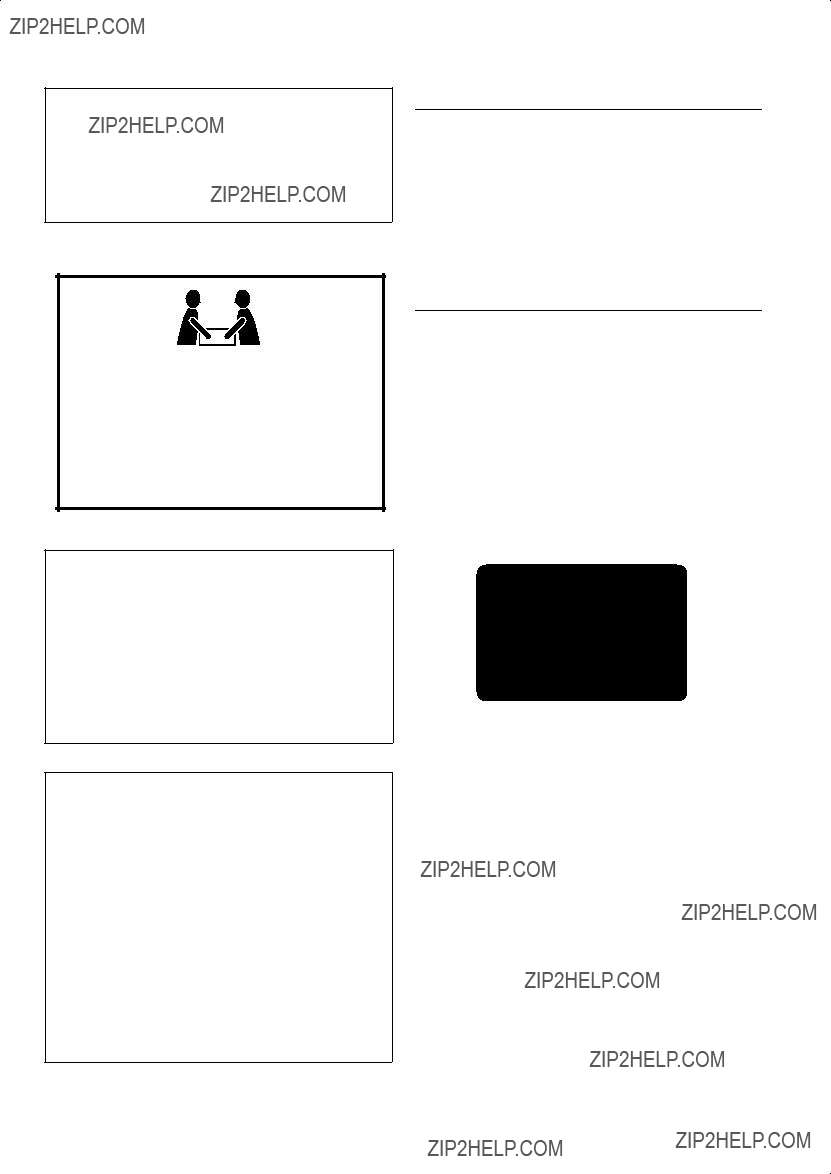
Note to CATV system installer:
This reminder is provided to call the CATV system installer???s attention to Section
IMPORTANT FOR LASER PRODUCTS
1CLASS 1 LASER PRODUCT
2CAUTION: Do not open the top cover. There are no user serviceable parts inside the Unit; leave all servicing to qualified service personnel.
3CAUTION: Visible and invisible laser radiation when open and interlock failed or defeated. Avoid direct exposure to beam.
4REPRODUCTION OF LABEL: CAUTION LABEL,
PLACED INSIDE UNIT.
30 kg / 67 lbs.
CAUTION!
To avoid personal injury or accidentally dropping the unit, have two persons unpack, carry, and install the unit.
ATTENTION!
Pour ??viter toute blessure personnelle ou chute accidentelle del???appareil, faites d??baller, transporter et installer l???appareil par deux personnes.
For Canada/pour le Canada
CAUTION: TO PREVENT ELECTRIC SHOCK,
MATCH WIDE BLADE OF PLUG TO WIDE SLOT,
FULLY INSERT.
ATTENTION: POUR EVITER LES CHOCS
ELECTRIQUES, INTRODUIRE LA LAME LA PLUS
LARGE DE LA FICHE DANS LA BORNE
CORRESPONDANTE DE LA PRISE ET POUSSER
JUSQUAU FOND.
For Canada/pour le Canada
THIS DIGITAL APPARATUS DOES NOT EXCEED
THE CLASS B LIMITS FOR RADIO NOISE
EMISSIONS FROM DIGITAL APPARATUS AS SET
OUT IN THE
EQUIPMENT STANDARD ENTITLED ???DIGITAL
APPARATUS,???
OF COMMUNICATIONS.
CET APPAREIL NUMERIQUE RESPECTE LES
LIMITES DE BRUITS RADIOELECTRIQUES
APPLICABLES AUX APPAREILS NUMIRIQUES DE
CLASSE B PRESCRITES DANS LA NORME SUR LE
MATERIEL BROUILLEUR: ???APPAREILS NUMERIQUES???,
MINISTRE DES COMMUNICATIONS.
IMPORTANT POUR PRODUITS LASER
1PRODUIT LASER CLASSE 1
2ATTENTION: N???ouvrez pas le couvercle sup??rieur. Il n???y a aucune pi??ce r??parable par l???utilisateur ?? l???int??rieur de l???appareil; confiez toute r??paration ?? un personnel qualifi??.
3ATTENTION: Risque de radiations laser wisible et invisible quand l???appareil est ouvert ou que le syst??me de verrouillage ne fonctionne pas ou a ??t?? mis hors service. ??vitez toute exposition directe au rayon.
4REPRODUCTION DE L?????TIQUETTE: ??TIQUETTE
DE PR??CAUTION PLAC??E ?? L???INTERIEUR DE
L???APPAREIL.
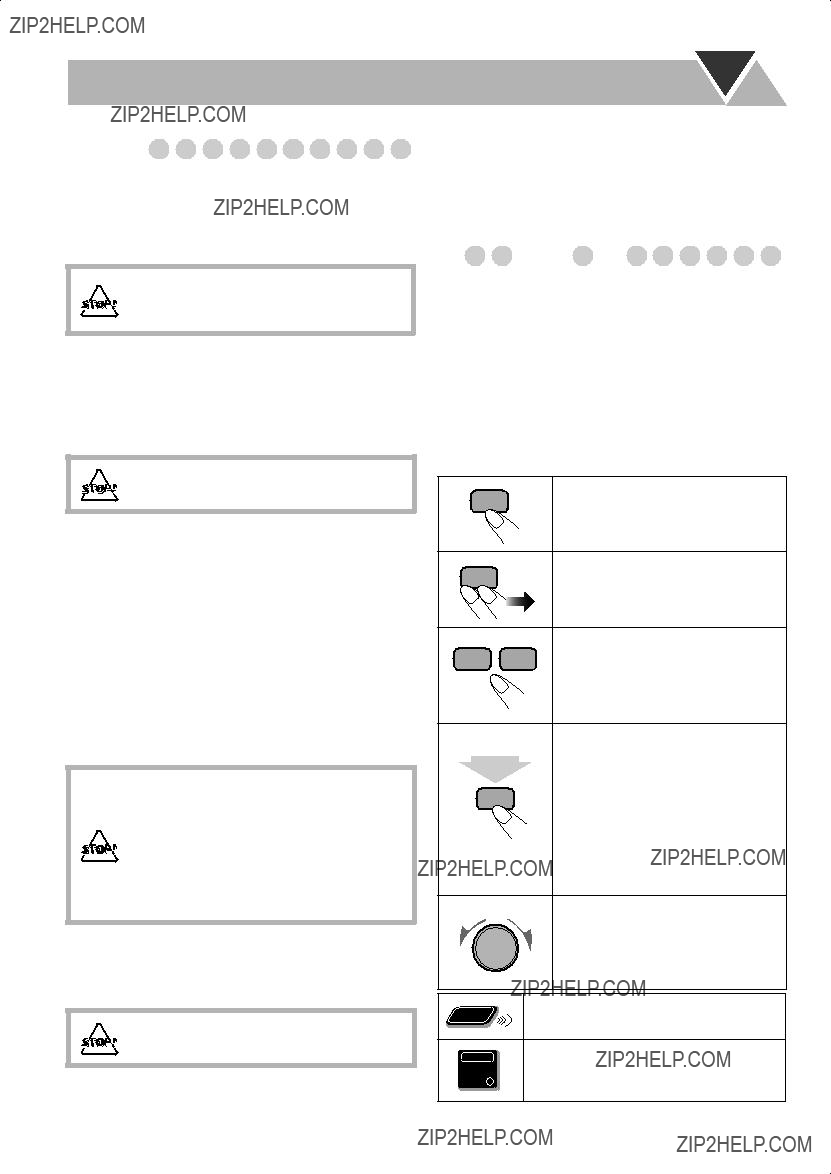
Introduction
Precautions
Installation
???Install in a place which is level, dry and neither too hot nor too
???Install the System in a location with adequate ventilation to prevent internal heat buildup in the System.
DO NOT install the System in a location near heat sources, or in a place subject to direct sunlight, excessive dust or vibration.
???Leave sufficient distance between the System and the TV.
???Keep the speakers away from the TV to avoid interference with TV.
Power sources
???When unplugging the System from the wall outlet, always pull on the plug, not the AC power cord.
DO NOT handle the AC power cord with wet hands.
Moisture condensation
Moisture may condense on the lenses inside the System in the following cases:
???After starting to heat the room
???In a damp room
???If the System is brought directly from a cold to a warm place.
Should this occur, the System may malfunction. In this case, leave the System turned on for a few hours until the moisture evaporates, unplug the AC power cord, then plug it in again.
Internal heat
???A cooling fan is mounted on the rear panel to prevent heat buildup inside the unit.
For safety, observe the following carefully:
???Make sure there is good ventilation around the unit. Poor ventilation could overheat and damage the unit.
???DO NOT block the cooling fan and the ventilation openings or holes. If they are blocked by a newspaper or cloth, etc., the heat may not be able to get out.
Others
???Should any metallic object or liquid fall into the System, unplug the AC power cord and consult your dealer before operating any further.
DO NOT disassemble the System since there are no user serviceable parts inside.
1
???If you are not going to operate the System for an extended period of time, unplug the AC power cord from the wall outlet.
If anything goes wrong, unplug the AC power cord and consult your dealer.
How to Read This Manual
To make the explanations in this manual as simple and easy-
???Button and control operations are explained as listed in the table below.
???Some related tips and notes are explained later in the sections ???Learning More about This System??? and ???Troubleshooting,??? but not in the same section explaining the operations. If you want to know more about the functions, or if you have a doubt about the functions, go to these sections and you will find the answers.
Indicates that you press the button briefly.
Indicates that you press the button briefly and repeatedly until an option you want is selected.
Indicates that you press one of the buttons.
Indicate that you press and hold the
button for an specified periods. 2 sec. ??? The number inside the arrow
indicates the period of press (in this example, 2 seconds).
???If no number is inside the arrow, press and hold until the entire procedure is complete or until you get a result you want.
Indicate that you turn the control toward the specified direction(s).
Indicates that this operation is only
Main Unitpossible using the buttons and controls on
ONLY
the main unit.

2
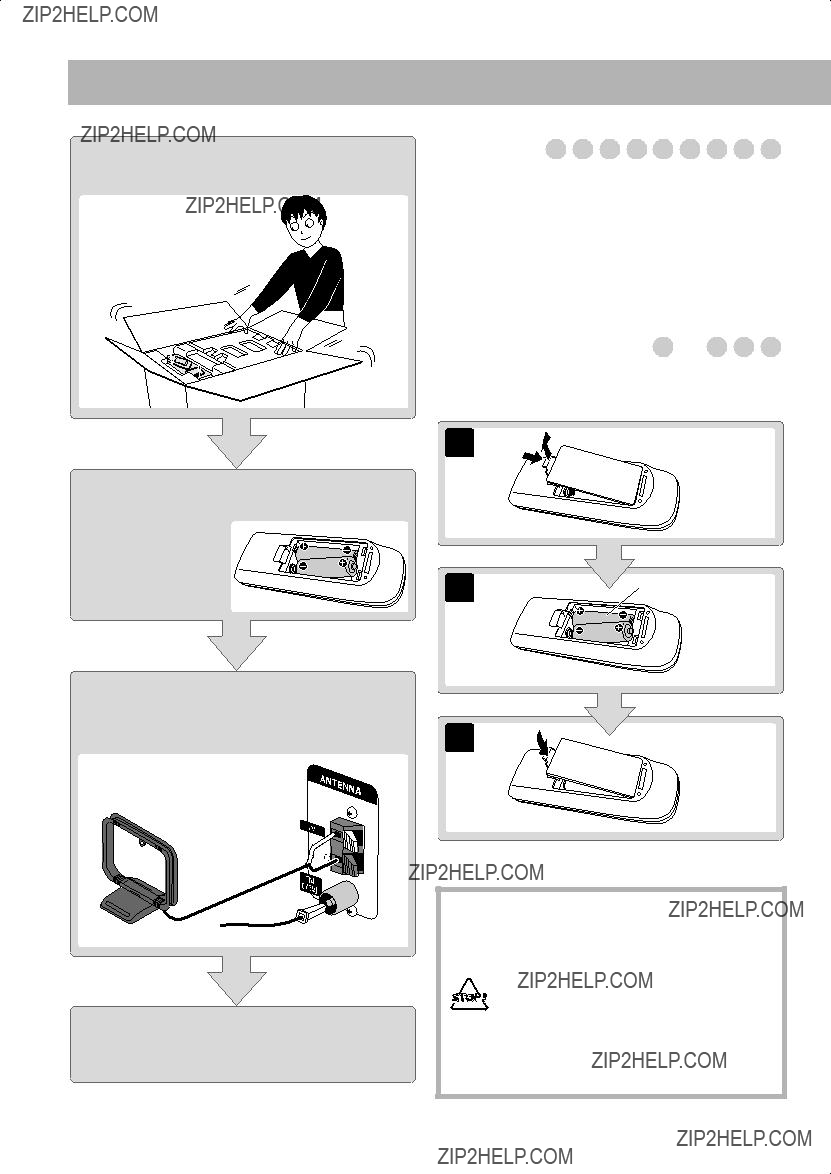
Getting Started
Step 1:Unpack the package and check the accessories.
Step 2: Prepare the remote control.
Step 1: Unpack
After unpacking, check to be sure that you have all the following items. The number in parentheses indicates the quantity of each piece supplied.
???FM antenna (1)
???AM loop antenna (1)
???Remote control (1)
???Batteries (2)
If any item is missing, consult your dealer immediately.
Step 2: Prepare the Remote Control
Insert the batteries into the remote control by matching the polarity (+ and
1
Finally plug the AC power cord.
Now you can operate this System.
???DO NOT use an old battery together with a new one.
???DO NOT use different types of batteries together.
???DO NOT expose batteries to heat or flame.
???DO NOT leave the batteries in the battery compartment when you are not going to use the remote control for an extended period of time. Otherwise, the remote control will be damaged from battery leakage.
3

Do not connect the power cord until all other connections have been made.
Step 3: Hook Up
If you need more detailed information, see page 5.
Illustrations of the input/output terminals below are typical examples.
When you connect other components, refer also to their manuals since the terminal names actually printed on the rear vary among the components.
Turn the power off to all components before connections.
FM antenna (supplied)
AM loop antenna (supplied)
Turn it until the best reception is obtained.
Extend it so that you can obtain the best reception.
To a wall outlet
Plug the AC power cord only after all connections are complete.
???Demonstration will start automatically. To cancel it, see page 8.
4

Do not connect the power cord until all other connections have been made.
To connect the speaker cords
???The supplied speakers do not conform to magnetically shielded design. Place the speakers enough distance from a TV so that they do not cause color irregularity on the TV.
???When connecting the speaker cords, match their polarity with that of the speaker terminals: red/blue to (+) and black to
???Use only speakers with the same speaker impedance as indicated by the speaker terminals on the rear of the unit.
IMPORTANT
???Always set volume to VOL MIN when connecting or disconnecting the other equipment.
DO NOT plug in any equipment until all connections are complete.
5

Before Operating the System
Parts Index

Refer to the pages to see how to use the buttons and controls.
Main unit
6

The indications on the display teach you a lot of things while you are operating the System.
Before operating the System, be familiar with when and how the indicator illuminates on the display.
Display Window
1 23 45
6 7 8 9 p q w e
Indications on the main display
??? While listening to radio:
BandFrequency
TRACK indicator
MP3*1:
TRACK indicator
MP3:
Total track number
??? While selecting ???AUX??? or ???USB???:
Source name
*1 At the playback beginning, the file name will be shown for a while after the track number and elapsed playing time.
*2 In the TRACK mode: Track number on the disc.
In the ALBUM mode: Track number in the current group (see page 11).
1BEEP ON indicator
???Lights when
2 Timer indicators
???DAILY: lights when the Daily Timer stands by or is working; flashes while the Daily Timer is being set.
???SLEEP: lights when the Sleep Timer is activated.
??? : lights when Daily Timer stands by or being set; flashes while the Daily Timer is working.
: lights when Daily Timer stands by or being set; flashes while the Daily Timer is working.
3RESUME indicator
???Lights when Resume Play for MP3 disc is activated.
4 Main display
5 Disc operation indicators
???PROGRAM: lights when Program Play mode is activated.
???RANDOM: lights when Random Play is activated.
???REPEAT: lights when Repeat Play mode is activated.
???ALL, 1, DISC:
???ALL DISC: lights when All Disc Play/Repeat is activated.
???1: lights when One Track Repeat is activated.
???1 DISC: lights when One Disc Play/Repeat is activated.
6 Audio level indicator
7 GROUP indicator
???Lights when the ALBUM mode is selected for MP3 playback.
8CD PLAY indicator
???Lights when ???CD??? is selected as the source.
9 Disc indicators
???Each indicator shows the status of a disc placed on the corresponding disc tray (DISC1 ??? DISC5).
???Lights up when a disc is detected.
???Flashes when the tray is currently selected.
???Goes off when the unit detects there is no disc loaded on the disc tray.
pTRACK indicator
???Lights when a CD is loaded.
???Lights when the TRACK mode is selected for MP3 playback.
qS.MODE indicator
???Lights when the Sound mode is activated. w SURR. indicator
???Lights when the Surround mode is activated. e FM reception indicators
???ST: lights while an FM stereo station with sufficient signal strength is tuned in.
???MONO: lights when monaural reception mode is selected.
7
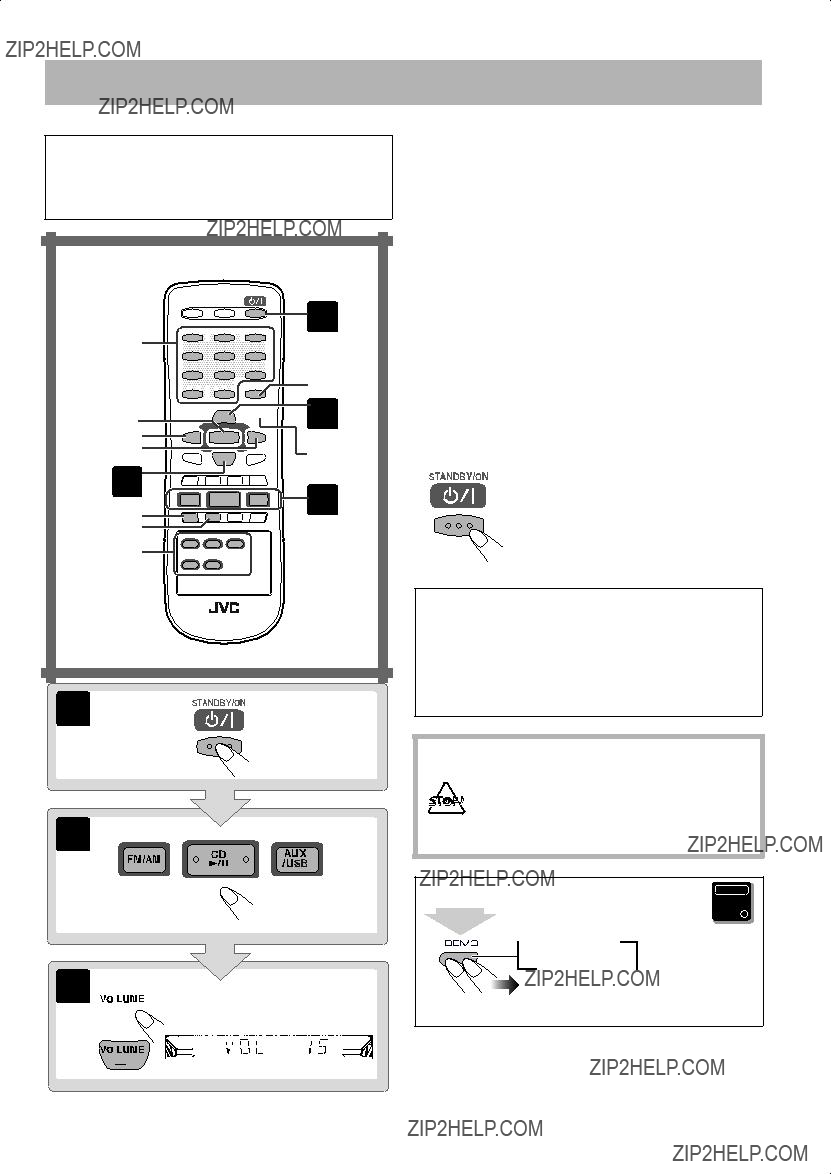
Daily
In this manual, the operation using the remote control is mainly explained; however, you can use the buttons and controls on the main unit if they have the same (or similar) name and marks.
1
10 keys
FM MODE/
MP3
7 

 3
3
3
2
REPEAT
PROGRAM
DISC 1??? 5
1
2
3 
?? Turn on the power.
The standby lamp on the main unit goes off.
???Without pressing STANDBY/ON  , the System also turns on by pressing one of the source select button in step
, the System also turns on by pressing one of the source select button in step
??.
?? Select the source.
Playback automatically starts if the selected source is ready to start.
???If you press AUX/USB, start playback source on the external audio component or the PC.
?? Adjust the volume.
[Operate the target source as explained later.
To turn off (stand by) the System
The standby lamp on the unit lights in red.
??? A small amount of power is always consumed even while on standby.
For private listening
Connect a pair of headphones to the PHONES jack on the main unit. The sound will no longer come out of the speakers. Be sure to turn down the volume before connecting or putting the headphones.
???Disconnecting the headphones will activate the speakers again.
DO NOT turn off (stand by) the System with the volume set to an extremely high level; Otherwise, the sudden blast of sound can damage your hearing, speakers and/or headphones when you turn on the System or start playback.
To cancel the demonstration
Main Unit
ONLY
 DEMO OFF
DEMO OFF
DEMO START
Press and hold until ???DEMO OFF??? appears on the display.
8
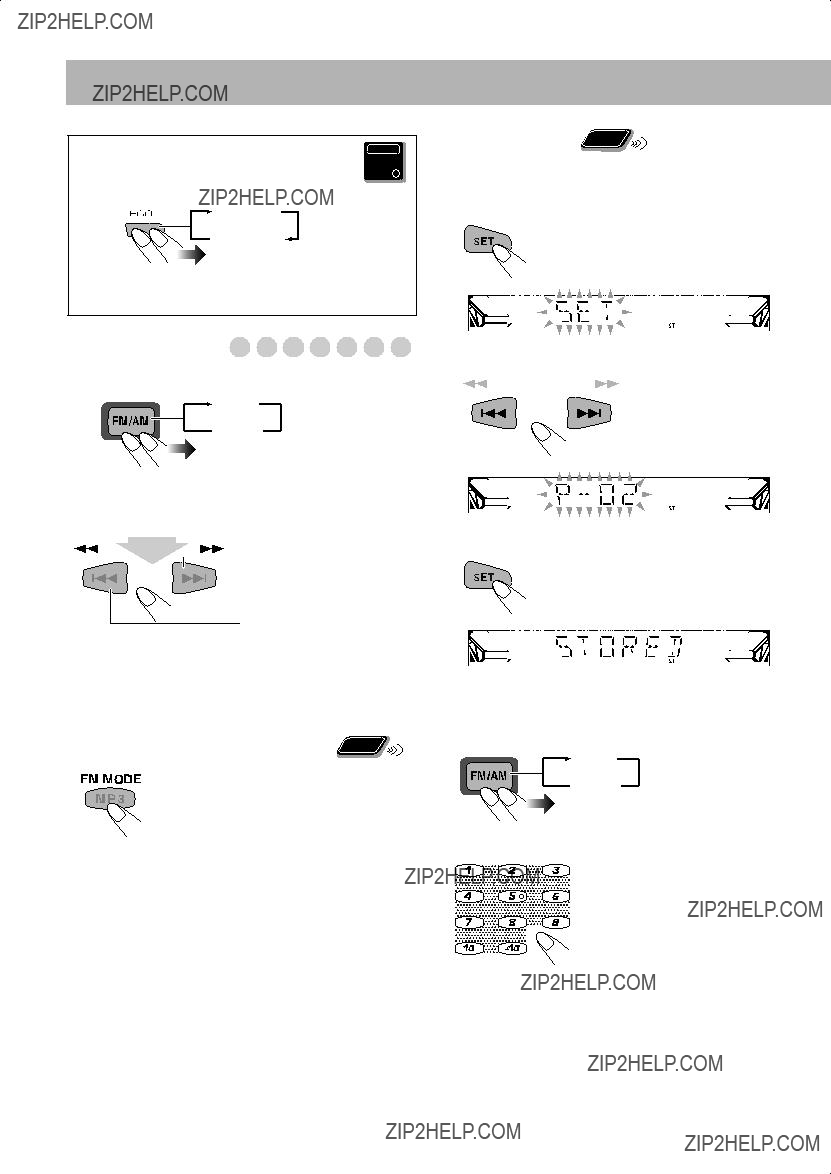
To save the power consumption while on
While on standby...
ECO
Canceled
The display illumination (including the display demonstration) disappears.
Listening to the Radio
To select the band (FM/AM)
FM
AM 
You can preset 30 FM and 15 AM stations.
1Tune in to a station you want to preset.
2Enter into the presetting mode.
3 Select a preset number for the station you store.
To tune in to a station
While FM or AM is selected...
2 sec.
 Increases the frequencies.
Increases the frequencies.
Decreases the frequencies.
When a station (frequency) with sufficient signal strength is tuned in, the frequency search stops.
To stop searching manually, press either button.
The MONO indicator lights on the display. Reception will improve though stereo effect is
To restore the stereo effect, press the button again (the MONO indicator goes off).
4 Store the station.
To tune in to a preset station
1 Select the band (FM or AM).
FM
AM 
2 Select a preset number for the station you store.
Examples:
To select preset number 5, press 5.
To select preset number 15, press +10, then 5.
To select preset number 30, press +10, +10, then 10.
??? You can also use the PRESET +/??? control on the unit.
9
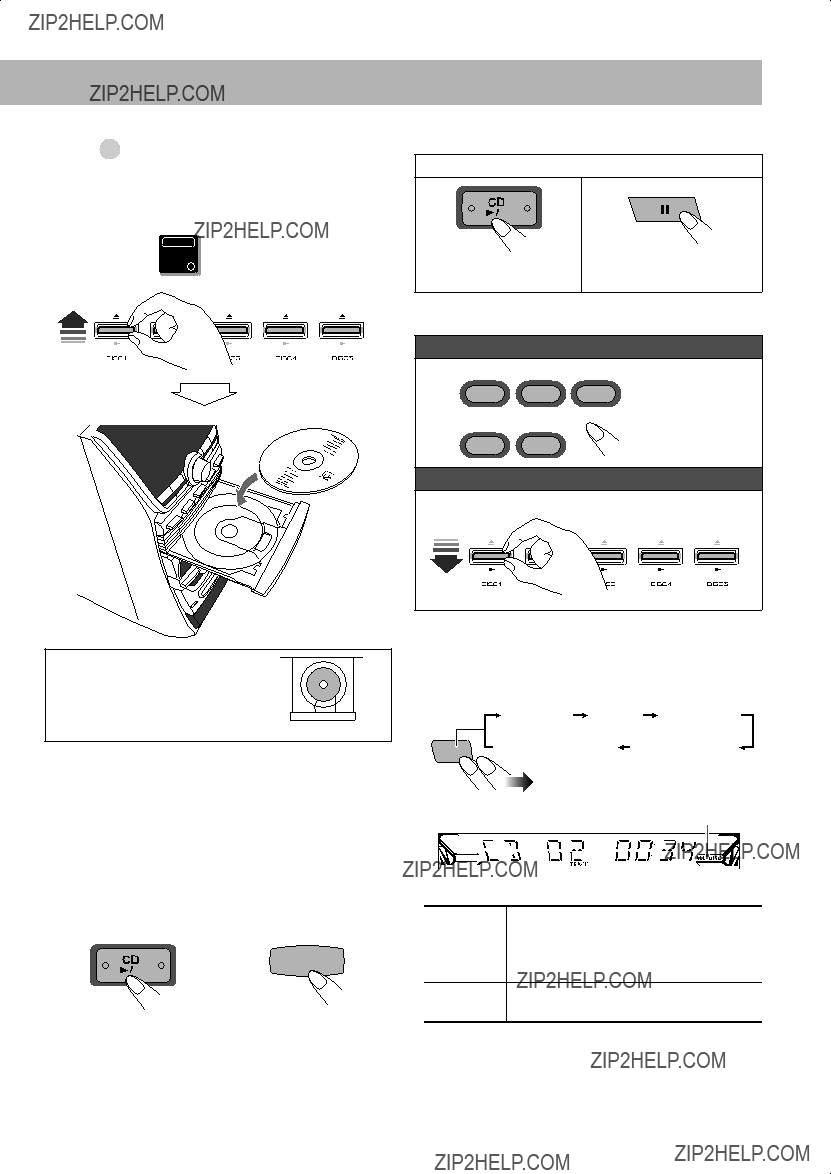
Playing Back a Disc 






This System can play back the following
To insert discs Main Unit
ONLY
???When using an 8 cm disc, place it on the inner circle of the disc tray.
To close the disc tray, push up the same control (0) again. If you push down the same control (3), the disc tray closes automatically and playback starts.
???When you push up the control (0) for the next tray you want to place another disc onto, the first disc tray automatically closes and then next tray comes out.
???When you load an MP3 disc, you can select playback mode. See ???To select MP3 playback mode??? on page 11.
To pause playback
To select a playback disc
Remote control:

 1
1 
 2
2 
 3
3

 4
4 
 5
5
Main unit:
Ex.: To select DISC 1
Playback of the selected disc starts.
???You can play all loaded discs
Before playback or while playing...
ALL DISC indicator
Ex.:When All Disc play is selected.
ALL DISC All the loaded discs are played in sequence.
Ex.: When playback starts from DISC 2:
DISC 2]DISC 3]DISC 4]DISC5]
DISC 1](then stops)
1 DISC Playback stops when all tracks on the selected disc are played once.
10

To select a track
??? See the right column for an MP3 disc.
While playing a disc...
Increases the track numbers.
Decreases the track numbers.
To locate a particular portion
While playing a disc, press and hold the button until the portion you want is reached.

To skip MP3 tracks
 TRACK
TRACK
ALBUM 
In the TRACK mode:
Selects a track number on the current MP3 disc.
In the ALBUM mode:
Selects a track number in the current group.
To select a group on an MP3 disc
 TRACK
TRACK
ALBUM 
Examples:
To select track 5, press 5. To select track 15, press +10, then 5.
To select track 30, press +10, +10, then 10.
Selected group number
Track number in the selected group
Before playback or while playing an MP3 disc...
 TRACK
TRACK
ALBUM 
TRACK The System recognizes only tracks (files). mode You can play an MP3 disc like an Audio CD.
ALBUM The System recognizes tracks (files) and mode albums (groups) on an MP3 disc. You can
play the MP3 disc according to the way how they are grouped. (The GROUP indicator lights up on the display.)
The first track of the selected group starts playing.
Resume Play for MP3 discs
While playing an MP3 disc, this System can store the number of the track that you have stopped playback. By pressing CD 6, you can start playback again from the beginning of the same
To activate/deactivate Resume Play
RESUME ON
RESUME OFF
PROGRAM
11
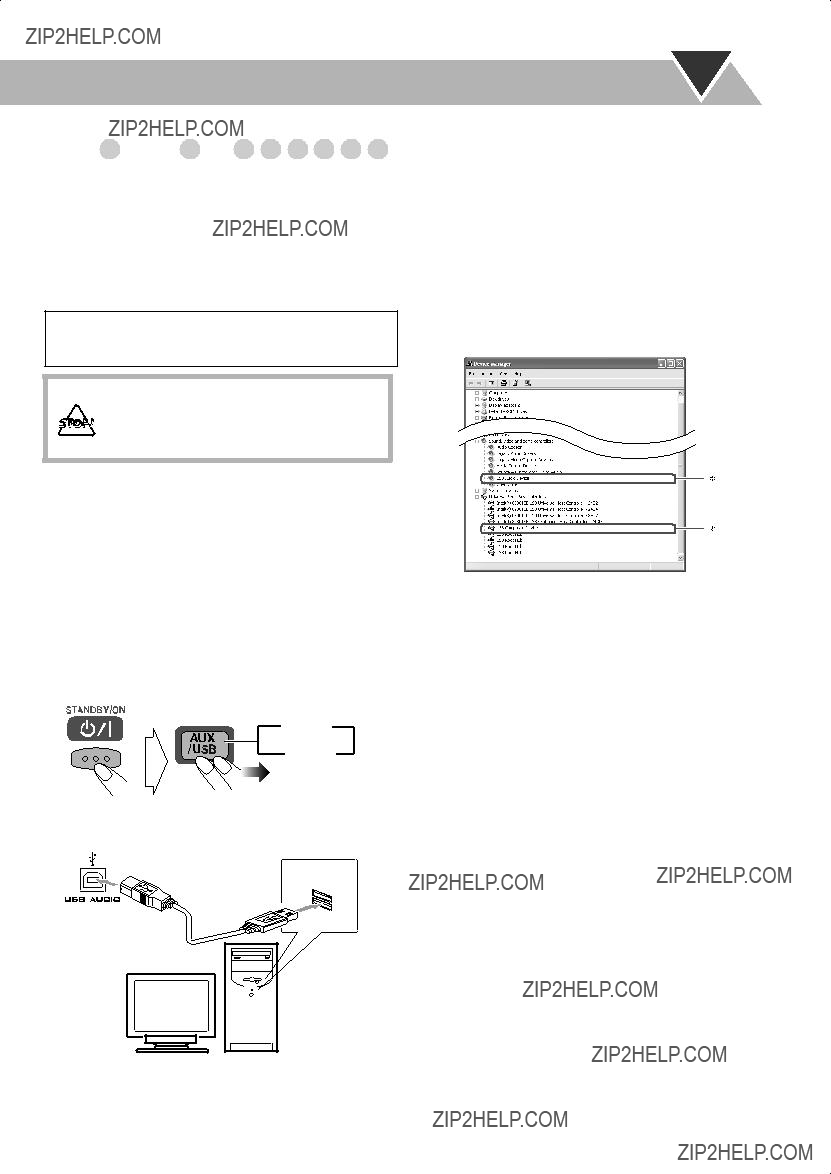
Playing Back from the PC
This System is equipped with a USB terminal on the front panel. You can connect your PC to this terminal and enjoy sound reproduced through your PC.
When you connect your PC for the first time, follow the procedure below.
???Remember you cannot send any signal or data to your PC from this System.
IMPORTANT
???Always set volume to VOL MIN when connecting or disconnecting the other equipment.
DO NOT turn off the System and disconnect the USB cable while installing drivers and playing back, and for several seconds after your PC recognizes the System.
How to install the USB drivers
The following procedure is described using the English version of WindowsR XP. If your PC is running on a different version of Windows, the screens shown on your PC???s monitor will differ from the ones used in the following procedure.
1Turn on your PC and start running WindowsR 98SE, WindowsR Me, WindowsR 2000 or WindowsR XP.
???If the PC has been turned on, quit all the applications now running.
2Turn on the System and select USB for the source.
 AUX
AUX
USB 
3Connect the unit to the PC using a USB cable (not supplied).
USB cable
(front panel)
PC
???Use ???USB series A plug to B plug??? cable when connecting.
4The USB drivers are installed automatically.
???If the USB drivers are not installed automatically, install the USB drivers following the instructions on the PC???s monitor.
5Check if the drivers are correctly installed.
1 Open the Control Panel on your PC: Select [Start] = [Settings] = [Control Panel]
2 Click [System] = [Hardware] = [Device Manager]
=[Sound, video and game controllers] and [Universal Serial Bus controllers]
???The following window appears, and you can check whether the drivers are installed.
*The installed drivers can be shown only when the System is connected to the PC.
To play back sounds on the PC
Refer to the manuals supplied with the sound reproduction application installed in the PC.
???Noise and static electricity may stop the sound through the USB connection. In this case, do the following operations:
???Disconnect and connect the USB cable again.
???Restart the music software on your PC.
???Turn off and on the System.
???Microsoft??, Windows?? 98SE, Windows?? Me, Windows?? 2000 and Windows?? XP are registered trademarks of Microsoft corporation.
12
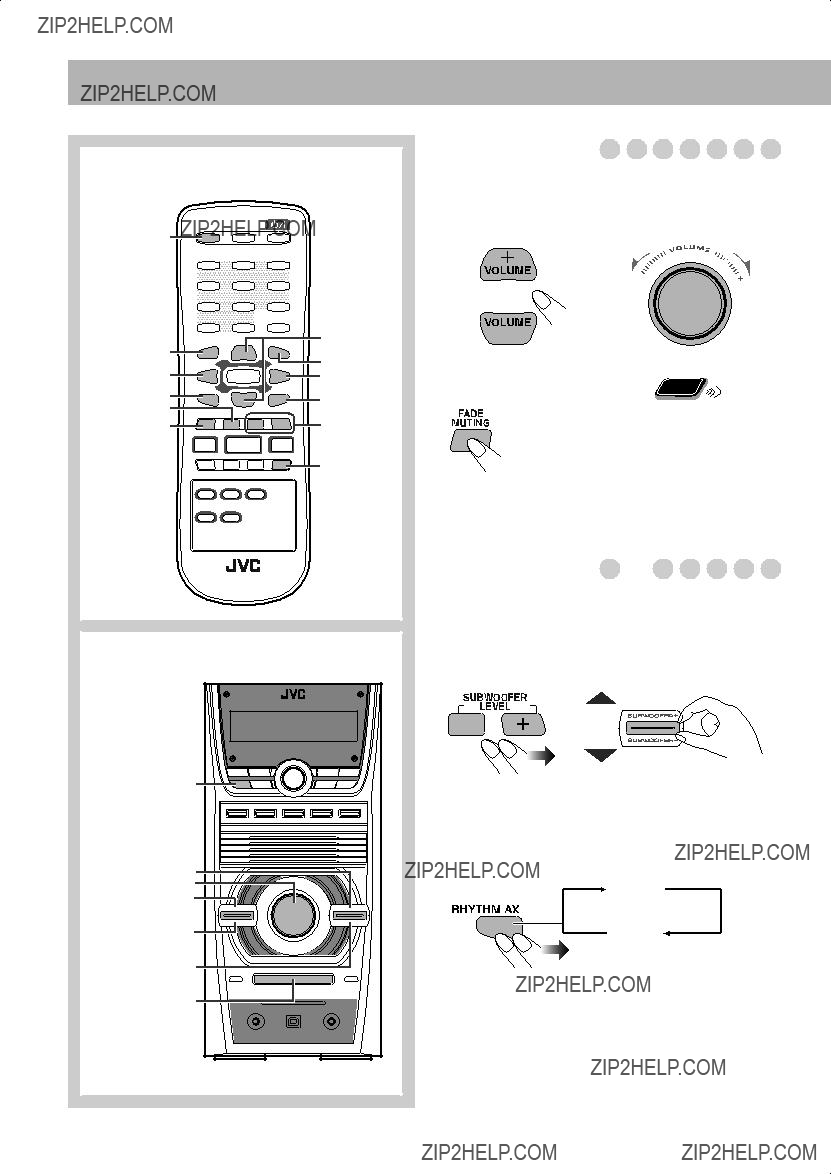
Daily
Main unit
Adjusting the Volume
The volume level can be adjusted in 32 steps (VOL MIN, VOL 1 ??? VOL 30, and VOL MAX).
Remote
To restore the volume, press the button again, or adjust the volume level.
Reinforcing the Bass Sound
To adjust the subwoofer level gradually
You can select the subwoofer level from level 0 (minimum) to level 2 (maximum).
To emphasize rhythm
This function emphasizes bass attack feeling, and also changes the subwoofer level.
ON
(subwoofer level 2)
OFF
(subwoofer level 0)
13
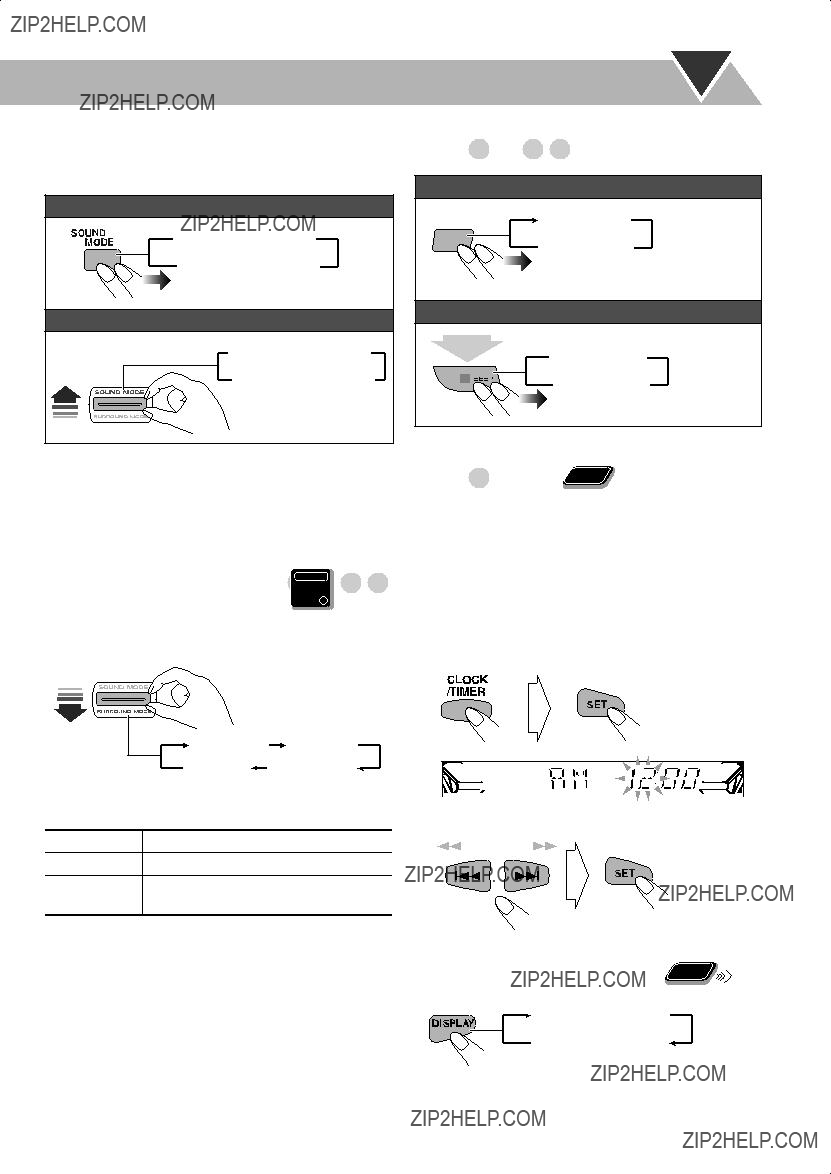
Selecting the Sound Modes




You can select one of the preset Sound Modes.
Remote control:
 ROCK
ROCK  POP
POP
OFF CLASSIC
CLASSIC 
(Canceled)
Main unit:
 ROCK
ROCK  POP
POP
OFF CLASSIC
CLASSIC 
(Canceled)
Turning On or Off the 

Remote control:
BEEP ON
BEEP OFF 
BEEP
Main unit:
2 sec.
 BEEP ON
BEEP ON
BEEP OFF 
Selecting the Surround Modes Main Unit
ONLY
You can select one of the Surround Modes to create being- there feeling in your room.
Setting the Clock Remote
Remote 





ONLY
Without setting the
???To exit from the clock setting, press CLOCK/TIMER as required.
???To go back to the previous step, press CANCEL.
???If you have already adjusted the clock before, press CLOCK/TIMER repeatedly in step 1, until the clock setting mode is selected.
1 Enter into clock setting mode.
STADIUM Adds clarity and spreads the sound, as in an outdoor stadium.
Now the
To check the current time during play
Clock
Source information
Remote
ONLY
14
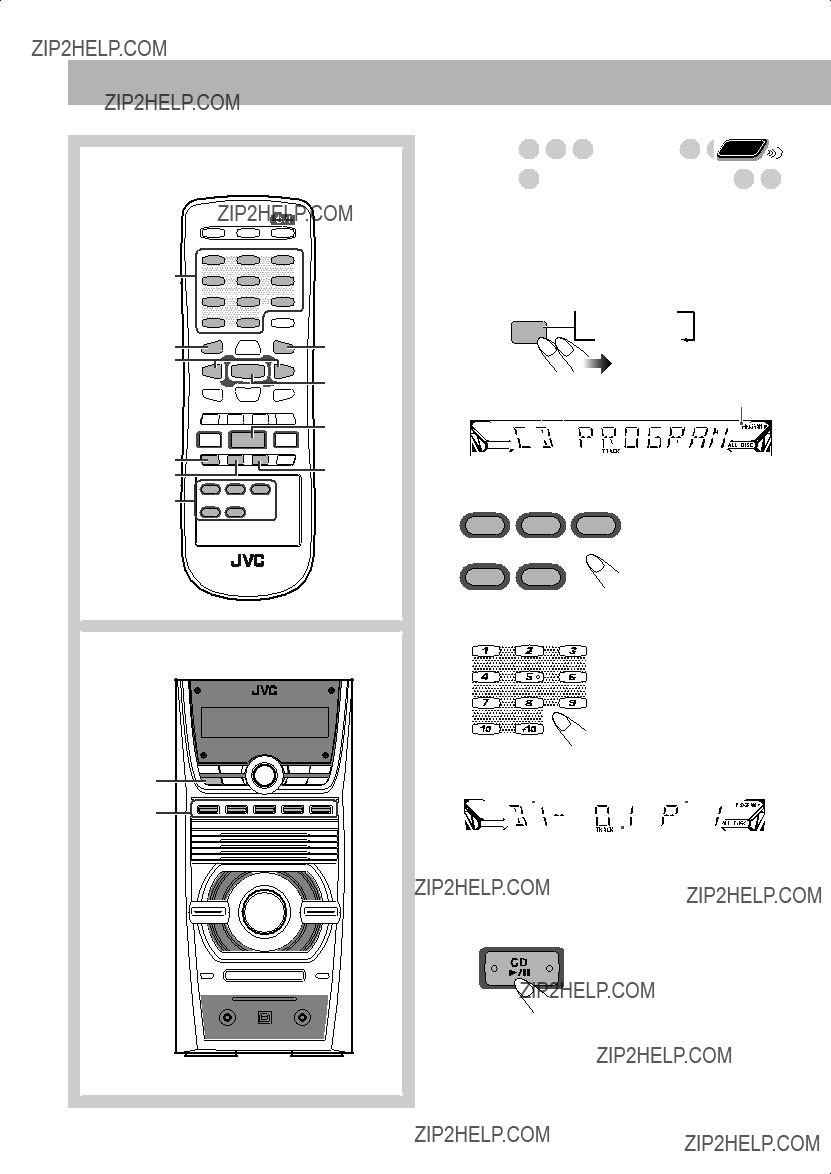
Advanced Disc Operations
Main unit






You can arrange the playing order of the tracks (up to 32 tracks) before you start playback.
??? Program Play cannot be used for MP3 discs.
1 Before starting playback, activate Program Play.
 PROGRAM
PROGRAM
Canceled
PROGRAM
PROGRAM indicator
2 Select a disc.

 1
1 
 2
2 
 3
3

 4
4 
 5
5
3 Select tracks you want for Program Play.
Examples:
To select track 5, press 5. To select track 15, press +10, then 5.
To select track 30, press +10, +10, then 10.
Track number
4Repeat steps 2 and 3 until you program all tracks you want.
5Start playback.
The tracks you have selected are played back in the order you have programmed.
???When all the programmed tracks played, the System exits from Program Play.
15
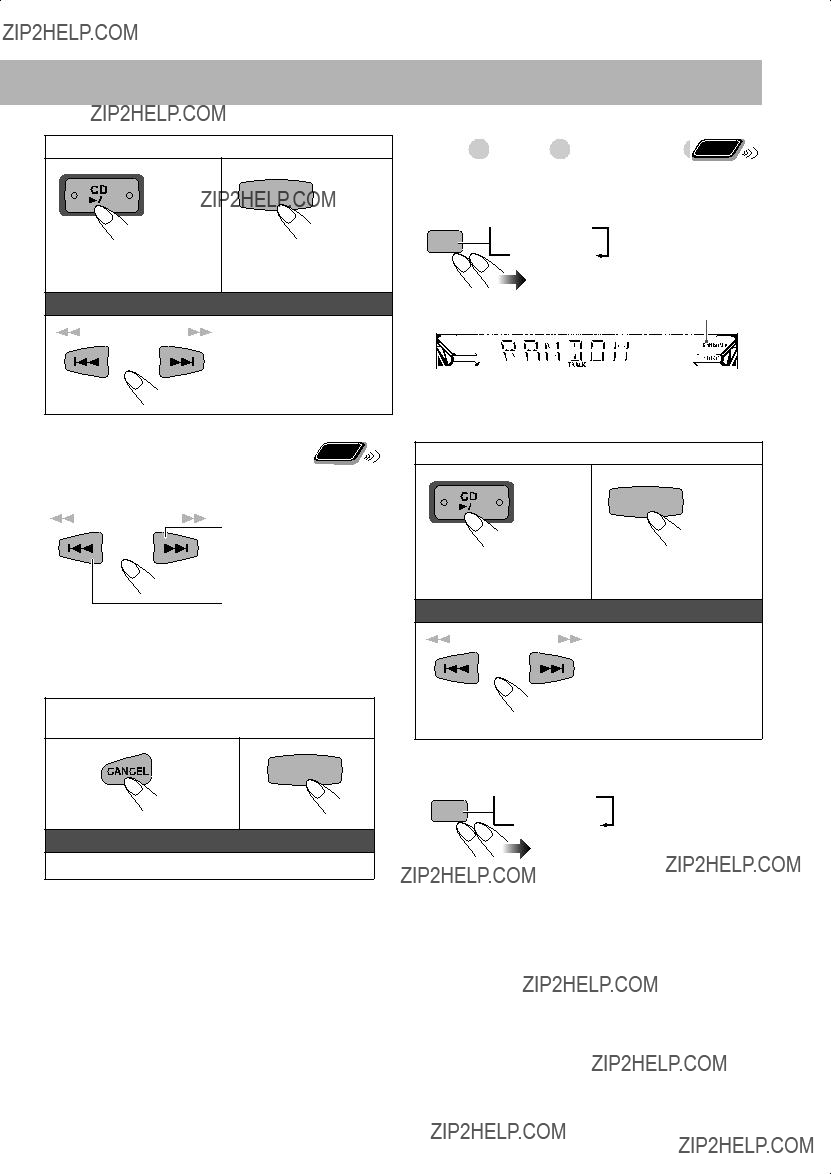
To skip:
Remote
While the PROGRAM indicator lights on the display and
before playback...
in the programmed order.
in the reverse order.
To modify the program
While the PROGRAM indicator lights on the display and
before playback...
You can play the contents of the current disc at random.
Before playback or while playing...
 RANDOM
RANDOM
Canceled
RANDOM
RANDOM indicator
Random Playback starts. Random Play ends when all the contents of the disc are played.
To skip:
Playback skips to the next track selected randomly.
To exit from Random Play while playback...
 RANDOM
RANDOM
To add steps in the program
Repeat steps 2 and 3 on page 15.
RANDOM
Canceled
16

You can repeat playback.
???Repeat Play and Random Play cannot be used at the same time.
Before playback or while playing...
 ALL DISC*
ALL DISC*  1 DISC*
1 DISC*  REPEAT 1
REPEAT 1
REPEAT ALL DISC  REPEAT 1 DISC
REPEAT 1 DISC 
REPEAT
* See page 10.
Repeat mode indicators
Ex.: When One Disc Repeat (???REPEAT 1 DISC???) is selected.
REPEAT 1 DISC Repeats all tracks on the current disc.
REPEAT ALL DISC Repeats all tracks on all the loaded discs.
??????REPEAT 1 DISC??? cannot be selected for Program Play. It is also canceled when you select Program Play.
To exit from Repeat Play while playback...
 ALL DISC
ALL DISC  1 DISC
1 DISC  REPEAT 1
REPEAT 1
Prohibiting Disc
ONLY
You can prohibit disc ejection from the System and lock discs.
???This operation is possible only when the source is the CD player.
While the disc tray is closed...
1 Push up and hold 0 for any disc tray while holding 7.
(while holding...)
2 Release 7, then 0.
???If you try to eject discs while Tray Lock is in use, ???LOCKED??? appears to inform you that the disc trays are locked.
To cancel the prohibition, repeat the same procedure. ???UN LOCKED??? appears on the display.
REPEAT 
REPEAT ALL DISC  REPEAT 1 DISC
REPEAT 1 DISC 
17
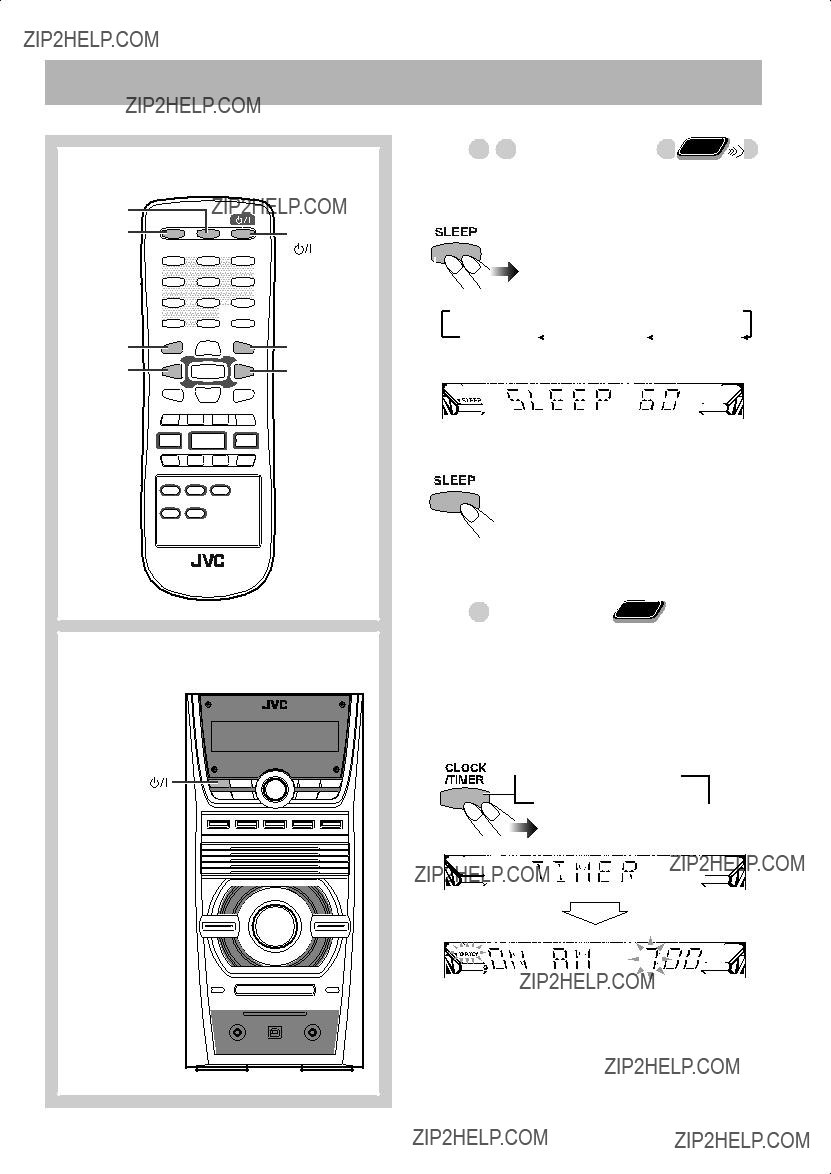
Timer Operations
Main unit
With Sleep Timer, you can fall asleep to music.
While the System is turned on...

 SLEEP 10
SLEEP 10  SLEEP 20
SLEEP 20  SLEEP 30
SLEEP 30  SLEEP 60
SLEEP 60
(Canceled)
To check the time remaining until the
??? If you press the button repeatedly, you can change the
Setting the Daily Timer  Remote
Remote 



ONLY
Using Daily Timer, you can wake up with your favorite song.
???To correct a misentry during the process, press CANCEL. You can return to the previous step.
1Select the timer setting mode for Daily Timer??? ???TIMER ON.???
 DAILY
DAILY  TIMER (ON)
TIMER (ON)
Canceled  Clock setting
Clock setting
18

2 Set the hour then minute for
3 Set the hour then minute for
4Select the playback
To turn off the Daily Timer
Since Daily Timer is activated at the same time everyday, you may need to cancel it on some particular days.
 DAILY
DAILY  TIMER (ON)
TIMER (ON)
Canceled  Clock setting
Clock setting
Ex.: When ???TUNER FM??? is selected.
1Select a preset station for ???TUNER FM??? and ???TUNER AM.???
2 Select the volume level.
5Turn off the System (on standby) if you have set the timer with the System turned on.
How Daily Timer actually works
Once the Daily Timer has been set, the timer (  ) indicator and DAILY indicator are lit on the display. Daily Timer is activated at the same time everyday until the timer is turned off manually (see the next column).
) indicator and DAILY indicator are lit on the display. Daily Timer is activated at the same time everyday until the timer is turned off manually (see the next column).
When the
The System turns on, tunes in to the specified station or start playing the specified source, and sets the volume level to the preset level.
When the
The System stops playback, and turns off (stands by).
???The timer setting remains in memory until you change it.
??? The timer (  ) indicator goes off.
) indicator goes off.
To turn on the timer again...
 DAILY
DAILY  TIMER (ON)
TIMER (ON)
Canceled  Clock setting
Clock setting
19

Additional Information
Learning More about This System


Daily
Listening to the Radio:
???When you repeatedly press ??/1, the frequency changes step by step.
???If you store a new station into an occupied preset number, the previously stored station in that number will be erased.
???When you unplug the AC power cord or if a power failure occurs, the preset stations will be erased in a few days. If this
happens, preset the station again.
Playing Back a Disc:
???The
???This System cannot play ???packet write??? discs.
???For MP3 playback...
???MP3 discs require a longer readout time than regular CDs. (It depends on the complexity of the group/file configuration.)
???Some MP3 files cannot be played back and will be skipped. This result from their recording processes and conditions.
???When making MP3 discs, use ISO 9660 Level 1 or level 2 for disc format.
???This System can play back MP3 files with the extension code <.mp3> (regardless of the letter
???It is recommended that you make each MP3 files at a sampling rate of 44.1 kHz and at bit rate of less than 64 kbps.
???This System manages files and folders as ???tracks??? and ???groups.???
???This System can recognize up to 90 groups per disc (up to 750 tracks).
???You can exchange discs while playing or selecting another disc.
???One Disc Play is also canceled when you change the source or turn off the System.
???If the MP3 file has ID3 Tags (Version 1.0 or 1.1), the track title (???<TITLE>???) and performer name (???<ARTIST>???) will be shown after the file name appears.
???Your entry will be ignored if you have tried to enter a track number that does not exist on the disc or in the group (for example, selecting track 14 in the group that only has 12 tracks).
???The memory of the track number for Resume Play will be erased when you eject the disc or you change the disc to play.
???If you unplug the AC power cord, Resume Play is back to on.
Daily
(see pages 13 and 14)
Adjusting the Volume:
???Be sure to turn down the volume before connecting or putting the headphones.
???When you turn off the System with the volume level set to ???VOL 16??? or higher, the volume level is reset to ???VOL 15???
next time you turn on the System.
Adjusting the Sound:
???This function also affects the sound through the headphones.
???The subwoofer lamp(s) indicates the current subwoofer
Selecting the Sound Modes:
??? The sound mode lamp lights when one of the sound mode is activated.
Selecting the Surround Modes:
??? The Surround mode lamp lights when one of the Surround mode is activated.
Setting the Clock:
??? ???-
Advanced Disc Operations (see pages 15 to 17)
???While programming steps...
???If you try to program a disc number which the System has not read, ???NO READ??? appears on the display.
???If you try to program a disc number on which no disc is loaded, ???NO DISC??? appears on the display.
???Your entry will be ignored if you have tried to program an item number that does not exist on the disc (for example, selecting track 14 on a disc that only has 12 tracks). Such entries are ignored.
???If you try to add a 33rd track, ???FULL??? appears on the display.
???The program contents will be erased when...
???You unplug the AC power cord.
???You open the disc tray currently selected (regardless of the
play mode).
Playing at
???Activating Random Play cancels Repeat Play or All Disc Play. (One Disc Play is automatically selected.)
???Activating Random Play for an MP3 disc changes the ALBUM mode to the TRACK mode.
???Random Play is also canceled when you eject the disc or
change the disc to play.
Repeating
???Repeat Play is also canceled when you change the source or turn off the System.
Timer Operations (see pages 18 and 19)
Turning Off the Power Automatically:
???If you turn off the System, Sleep Timer is canceled.
Setting the Daily Timer:
???When you unplug the AC power cord or if a power failure occurs, the timer will be canceled. You need to set the clock first, then the timer again.
20
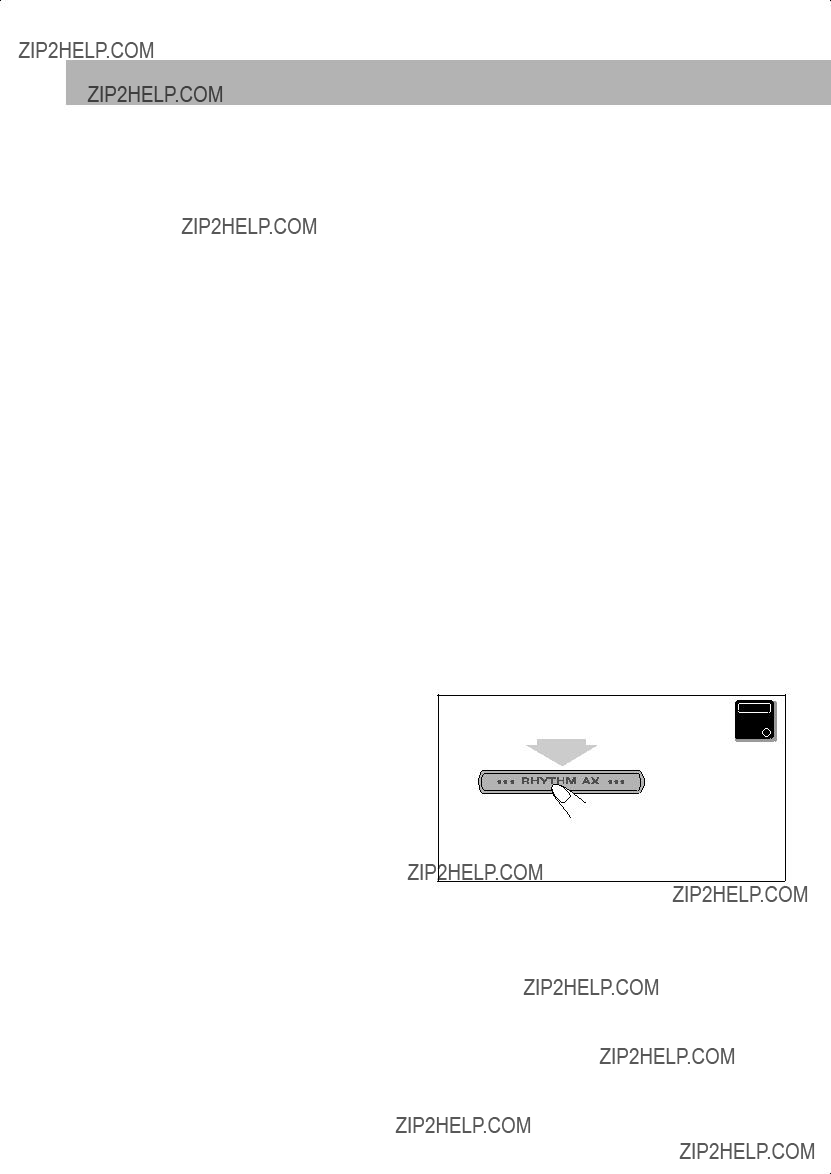
Maintenance 








To get the best performance of the System, keep your discs clean.
Handling discs
???Remove the disc from its case by holding it at the edge while pressing the center hole lightly.
???Do not touch the shiny surface of the disc, or bend the disc.
???Put the disc back in its case after use to prevent warping.
???Be careful not to scratch the surface of the disc when placing it back in its case.
???Avoid exposure to direct sunlight, temperature extremes, and
moisture.
To clean the disc:
Wipe the disc with a soft cloth in a straight line from center to edge.
Cleaning the System
???Stains should be wiped off with a soft cloth. If the System is heavily stained, wipe it with a cloth soaked in
???Since the System may deteriorate in quality, it become damaged or get its paint peeled off, be careful about the following:
???DO NOT wipe it with a hard cloth.
???DO NOT wipe it strong.
???DO NOT wipe it with thinner or benzine.
???DO NOT apply any volatile substance such as insecticides to it.
DO NOT allow any rubber or plastic to remain in contact with it for a long time.
Troubleshooting 







If you are having a problem with your System, check this list for a possible solution before calling for service.
General:
Adjustments or settings are suddenly canceled before you finish.
] There is a time limit. Repeat the procedure again.
Operations are disabled.
]The
and then plug it back in.
Unable to operate the System from the remote control.
] The path between the remote control and the remote sensor on the System is blocked. Remove the obstruction.
] The batteries are exhausted.
No sound is heard.
] Speaker connections are incorrect or loose (see pages 4 and 5).
] Headphones are connected. Disconnect the headphones.
Radio Operations:
Hard to listen to broadcasts because of noise.
] Antenna connections are incorrect or loose (see pages 4 and 5).
] The AM loop antenna is too close to the System.
] The FM antenna is not properly extended and positioned.
Disc Operations:
The disc does not play.
] The disc is placed upside down. Place the disc with the label side up.
The disc sound is discontinuous.
] The disc is scratched or dirty.
The disc tray does not open or close.
] The AC power cord is not plugged in. ] Tray Lock is in use (see page 17).
]Program Play is in use. Exit from Program Play (see page 16).
USB Operations:
Unable to play back through the USB connection.
] USB connection and setting is incorrect (see page 12).
The sound through the USB connection stops.
]Noise and static electricity may stop the sound through the USB connection. In this case, do the following operations:
???Disconnect and connect the USB cable again
???Restart the music software on your PC
???Turn off and on the system
Timer operations:
Daily Timer does not work.
]The System has been turned on when the
If you still have a problem, reset the System.
Press and hold until the display flashes.
The factory default settings are restored and all the settings you have made are erased.
21

Specifications
Amplifier
Audio input sensitivity/impedance:
Tuner
CD player
General
Supplied accessories
See page 3.
Speaker
Design and specifications are subject to change without notice.
22



SYSTEM COMPONENT COMPACT